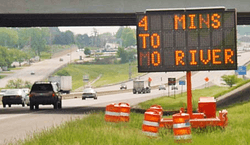Smart work zone

A smart work zone is a road work zone in which technology is employed to increase safety and provide information. Smart work zones often use radar guns or other non-intrusive sensors to detect the presence and speed of vehicles approaching a work zone, in order to display an appropriate message on one or more variable message signs.
In a "dynamic merge" system, for example, vehicles approaching a lane closure are directed to use all available lanes when congestion develops and speeds are low. When speeds are high, motorists are directed to merge early or are left to use their own judgement. Such a system is usually deployed in addition to traditional static messaging.
"Blind-area" diagrams can be generated using physical measurements and computer simulations to reveal the space around construction vehicles where workers and vehicles are at the highest risk of not being seen. A well-developed blind-area diagram can better inform construction crews on how to best block roads and position workers. Diagrams are created using a method jointly developed by the Caterpillar Inc. and the National Institute for Occupational Safety and Health which plots equipment on a grid and determines visibility of other objects relative to the equipment.